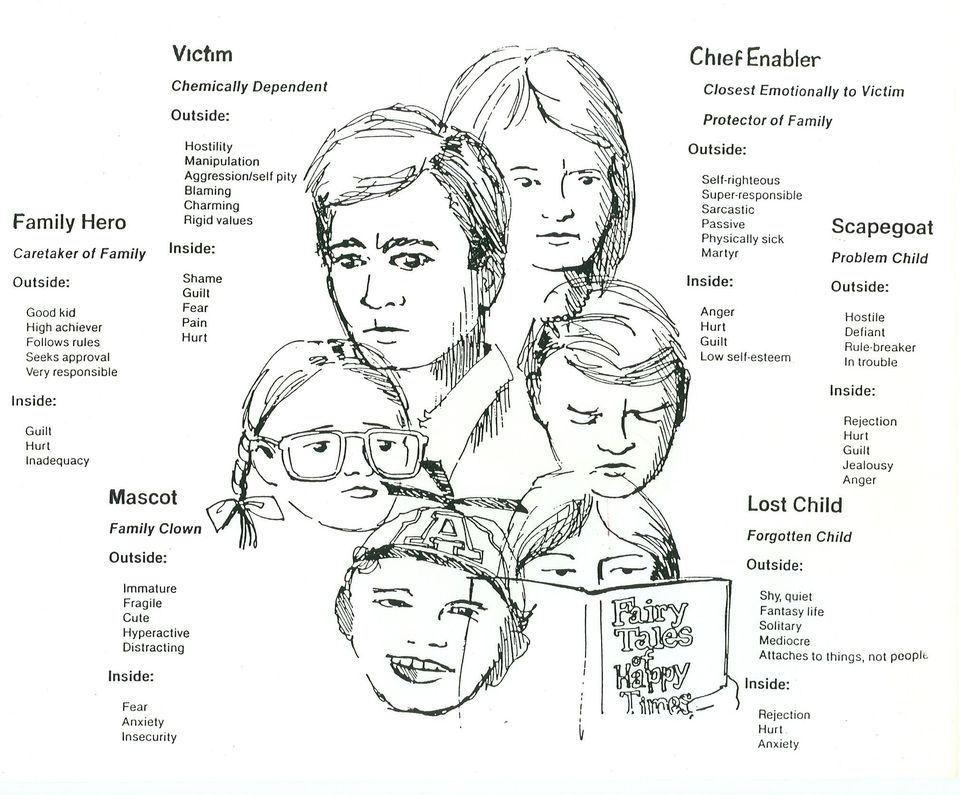Dysfunctional families: 4 roles taking by children
he family plays a fundamental role in a child’s mental health. It is emphasized that the husband and wife are the architects of the family. It is mainly up to them how the children will develop. So what happens in a home that is dysfunctional? What is a dysfunctional family and how does it function? What roles do children take?Based on Bradshaw, a dysfunctional family is created by a dysfunctional marriage, and such marriages are created by dysfunctional individuals who find each other and marry each other. People with dysfunctions very often find another person who acts either at the same level or at a higher level of dysfunction. Children growing up in a dysfunctional family are innocent, they have no control over the toxic environment in which they grow up. They are hurt by adults on different levels: physical, emotional, psychological, sexual. For such children, uncertainty, chaos and the instability of the environment are everyday life. Children from dysfunctional homes do not receive the attention and support they need in key stages of their development. Instead, they focus on the dysfunctional behavior of their parents. Very often they cannot show their feelings (especially anger, sadness and fear).What can cause family dysfunction? These are among others:- physical, emotional, sexual abuse,- addiction,- personality disorders and other psychological problems,- family conflicts between parents,- conflict between parent and child,- religious fanaticism,- abandonment,- neglect.For the family to survive, children take on different roles. They do it out of love for their parents, they undertake tasks that are beyond their capabilities. They work hard to maintain “balance” in the family. The roles described below serve the family, but not the children who play them:1.”Hero” – is a child who plays the role of an adult in the family. His job is to provide the family with self-esteem, hope, pride and success. The child takes on this role because one or both parents are emotionally unavailable due to their own problems. Despite the fact that he has not gone through the full cycle of adolescence and maturation and is unable to cope with such a challenge, he plays such a role, although internally he is not prepared for it. Usually takes on various responsibilities and copes with them very well (e.g. cooking, cleaning, raising younger siblings). He is brave, composed, dedicated and ready to give up on himself for others. The extended family, friends and neighbors often look at such a child with envy, praise and admire him. Thanks to the hero, the family can feel good, because it has brought up such a responsible and successful young person.2. “Scapegoat” – it allows the family to distract from their real problems. It treats the child as a kind of substitute object on which to concentrate and unload negative feelings. The scapegoat is the opposite of the family hero. Adults perceive such a child as irresponsible and difficult, bringing troubles and problems with their behavior. He often learns poorly, uses stimulants early, falls into the so-called “bad crowd”. He is usually brazen and arrogant towards parents. In this way, he expresses the negative emotions that family members react to him. The scapegoat, however, can be surprisingly similar to the family hero: he can take responsibility for what happens in the family. But the hero takes responsibility for the positive image of the family, and the scapegoat for the negative one. Children in both roles experience fear, a sense of rejection, loneliness and harm. The scapegoat also sometimes has a feeling of hatred towards the world and people who give him no chance to be good, as well as a feeling of jealousy and underestimation.3. “Mascot” – the mascot child is responsible for improving the mood and humor of the family. It provides a relief of tensions with laughter, antics, and humor in an otherwise sad family environment. It often becomes a home antidote to crisis moments. Many children who develop hyperactivity simply try to relieve tension in the family by fooling around and paying attention to themselves. Parents like to show off their mascot in front of others. At the same time, regardless of age, they treat child as an immature person who understands little of what is happening around him. Since he is not taken too seriously by the family, he is often not informed about various matters and does not take part in making decisions. When a mascot has to deal with someone else’s anger or rage against which adult household members are powerless, he is actually scared and tense. He has the feeling that if he cannot improve someone’s mood, he becomes unnecessary like an abandoned cuddly toy.4. “The invisible child” (also called the child in the fog or the lost child) – acts as if he was not there. He often feels that it would be better if he wasn’t there at all. He can take care of himself for hours. It does not cause any problems with education, usually it does not want anything. In social contacts it is withdrawn, sometimes considered shy. He does everything not to draw attention to himself. Sometimes he succeeds so well that he grows up in a kind of social isolation, despite the people around him. Such a child lacks basic interpersonal skills: establishing contact, expressing his needs or cooperating with others. At school, he clearly differs from his peers in the level of social skills.What was your role in your family?

